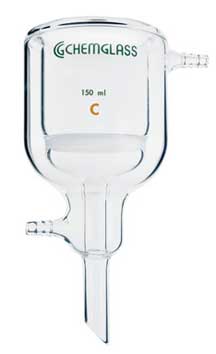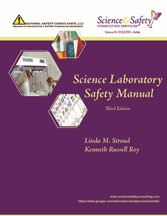



Find all of your laboratory and workplace safety supplies at Safety Emporium!
 Carbon Tetrachloride |
 Glossary Index |
 Carcinogen |
| MSDS Topics |
Free Sites | FAQ's | Regulations | Glossary | Software | Suppliers |
| Books | Forum | Poll | Fun stuff | Quiz | Store | |
| Understand your MSDS with the MS-Demystifier | Search ALL our MSDS info | |||||
A carboxylic acid contains a carboxy (carboxyl) group, COOH, which has one oxygen atom doubly bonded to the carbon atom and a hydroxy (OH) group singly bonded to the carbon atom. The carbon atom of the carboxy group must also be attached to an organic group or a hydrogen. Examples of common carboxylic acids include:

Carboxylic acids that have long (12 to 24 carbon atom) unbranched aliphatic groups are called fatty acids.

Need to filter something? We have all kinds of filtration apparatus like this one from Safety Emporium.
The hydrogen atom of the carboxyl group can dissociate (detach as H+) only to a very small extent, behavior that classifies carboxylic acids as weak acids. For example, we can say that the following equilibrium lies very far to the left side of the reaction (i.e. very little acetate anion forms in solution):

The names of carboxylic acids should end in "oic acid" according to official IUPAC nomenclature rules (see link below), however older common names that end in "ic acid" are still used. The "oic acid" naming scheme is superior because it unambiguously identifies the material as a carboxylic acid. In cases where another functional group takes naming precedence, "carboxy" is used as a prefix, although in certain cases the suffix "carboxylic acid" may also be used!

When a carboxylic acid is neutralized with a base it becomes a salt that is itself a weak base. The salt is named using the suffix "oate" instead of "oic acid". Sodium benzoate, shown below, is a common food preservative:

Carboxylic acids occur naturally in many organisms, and are primary components of your DNA. Examples of carboxylic acids you routinely encounter include ascorbic acid (vitamin C), acetic acid (vinegar is a 5% aqueous solution of vinegar), and citric acid (responsible for the sourness/tartness of citrus fruits).
Carboxylic acids are generally weak acids, but that does not mean that they can not be corrosive or pose other hazards. Section 8 (exposure controls/personal protection) of the Safety Data Sheet will discuss proper personal protective equipment (PPE) such as goggles and gloves to use when working with carboxylic acids. Take care to avoid storage or use with incompatible chemicals such as bases; such information will be found in Section 10 (stability and reactivity). Avoid storing carboxylic acids in metal cabinets, which can corrode. Carboxylic acids may also be flammable or combustible.
Acetic acid is a combustible organic chemical which should be stored in a flammable storage cabinet, NOT a corrosive storage cabinet. Acetic acid is incompatible with minerals acids such as nitric acid and hydrochloric acid so it should not be stored with them in a corrosive storage cabinet. To reduce the chance of corrosion, use a tray or secondary container for the carboxylic acids stored in your flammable solvent cabinet.

This guide to safer laboratories is just one of many safety reference books at Safety Emporium.
See also: acid, corrosive, ketone, pH.
Additional definitions from Google and OneLook.
Entry last updated: Saturday, May 21, 2022. This page is copyright 2000-2025 by ILPI. Unauthorized duplication or posting on other web sites is expressly prohibited. Send suggestions, comments, and new entry desires (include the URL if applicable) to us by email.
Disclaimer: The information contained herein is believed to be true and accurate, however ILPI makes no guarantees concerning the veracity of any statement. Use of any information on this page is at the reader's own risk. ILPI strongly encourages the reader to consult the appropriate local, state and federal agencies concerning the matters discussed herein.